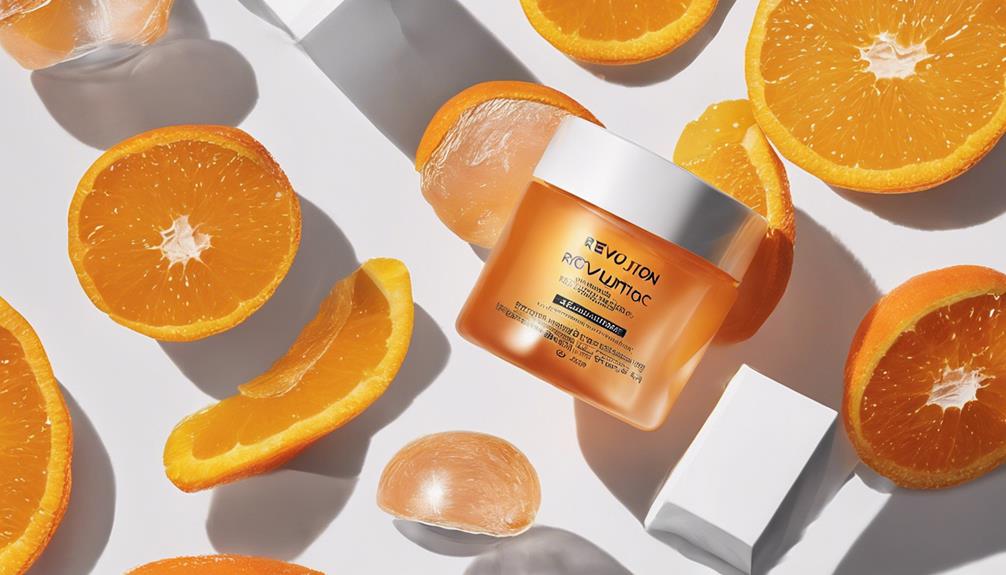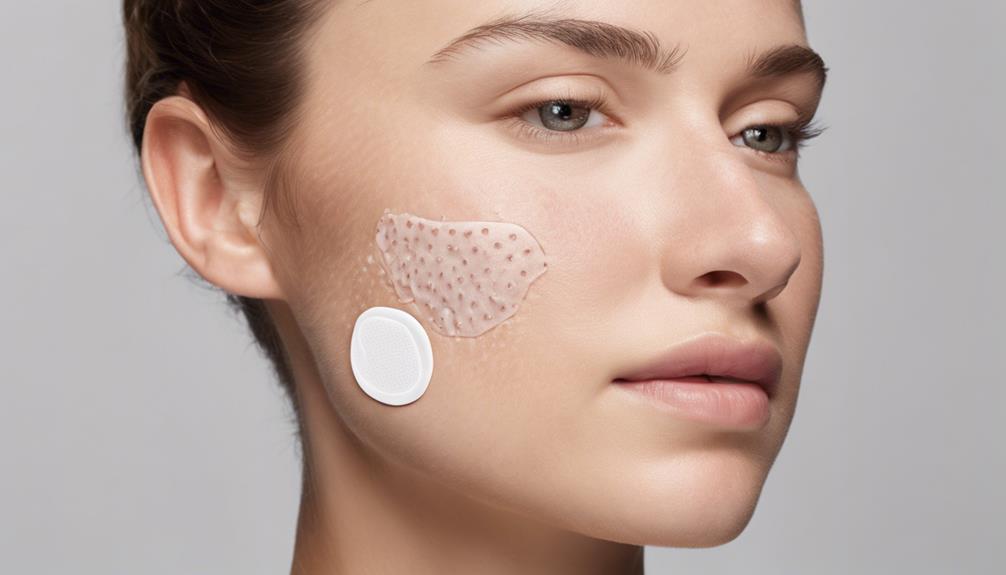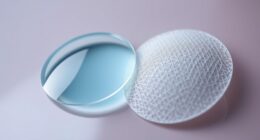Yes, pimple patches can effectively target early-stage breakouts. They reduce inflammation and absorb excess fluid, promoting quicker healing before the pimple worsens. By creating a protective barrier, these patches help prevent bacteria from spreading. However, they work best on inflamed, surface-level pimples. While they won’t eliminate cystic acne or closed lesions, they’re a great option for preventing breakouts from getting worse. There’s more to discover about their benefits and proper usage, so stick around!
Key Takeaways
- Pimple patches are most effective on inflamed pimples with visible heads, not on early-stage breakouts without heads.
- They absorb excess fluid and create a barrier that speeds up the healing process of surface-level acne.
- Pimple patches prevent the spread of bacteria and reduce inflammation, which can help minimize breakouts.
- Using hydrocolloid patches can calm redness and swelling, promoting faster recovery of blemishes.
- However, they are not suitable for cystic acne or closed lesions, and other treatments may be necessary for those cases.
Understanding Pimple Patches: What They Are and How They Work
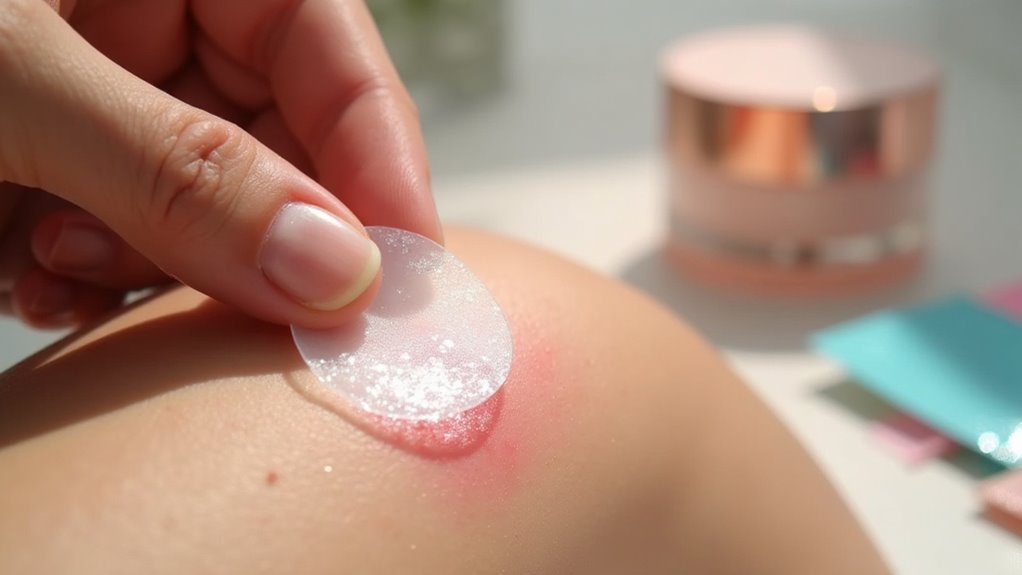
When you’re dealing with a breakout, pimple patches can be a game-changer.
These small, adhesive stickers are primarily made of hydrocolloid material, designed to absorb excess fluid and create a protective barrier over your pimples. By doing this, they help speed up the healing process.
Pimple patches effectively target surface-level acne, drawing out pus and sebum while preventing the spread of acne-causing bacteria and inflammation.
For the best results, apply them to clean, dry skin and let them sit for several hours or overnight. You’ll know they’re working when they turn opaque, indicating they’ve absorbed impurities.
Just remember, these patches are ideal for individual, inflamed pimples, not deeper types like cystic acne.
The Composition and Appearance of Pimple Patches

Pimple patches are a clever blend of materials designed to tackle breakouts effectively. Typically made from hydrocolloid, these patches create a gel-like barrier that forms a moist environment, helping to heal your skin while absorbing excess fluids from pimples.
You’ll find them in various shapes and sizes, often translucent or skin-toned, making them perfect for discreet wear during the day or under makeup. The thickness also varies; some are super thin for daytime use, while others are thicker for nighttime application, providing different levels of protection.
Many pimple patches include active ingredients like salicylic acid and tea tree oil, enhancing their acne-fighting capabilities. You can choose between sheets with multiple patches or individual acne stickers to target specific areas of concern.
Key Ingredients That Make Pimple Patches Effective

The effectiveness of pimple patches hinges on their key ingredients, which work synergistically to combat breakouts. Hydrocolloid patches absorb excess fluid, creating a moist environment for healing. Salicylic acid helps exfoliate the skin and targets acne-causing bacteria, reducing inflammation. Tea tree oil, known for its antibacterial properties, soothes the skin while minimizing the size and redness of pimples.
| Ingredient | Function |
|---|---|
| Hydrocolloid | Absorbs fluid, promotes healing |
| Salicylic Acid | Exfoliates, reduces inflammation |
| Tea Tree Oil | Antibacterial, soothes and reduces redness |
Additionally, AHA/BHA-infused patches unclog pores, making them ideal for early-stage breakouts. These ingredients work together to enhance your skin’s overall clarity.
How to Correctly Use Pimple Patches for Best Results

To get the best results from pimple patches, start by thoroughly cleansing and drying your skin.
Next, choose a patch that fully covers the blemish without any folds.
Finally, leave it on for the recommended time to guarantee it works effectively.
Clean and Dry Skin
Achieving the best results with pimple patches starts with clean, dry skin. Always wash your face and hands thoroughly to remove dirt and oil. After cleansing, make certain your skin is completely dry before you apply a patch; moisture can hinder adhesion and reduce its effectiveness in absorbing excess fluid from the pimple.
| Step | Action | Purpose |
|---|---|---|
| Clean Your Skin | Wash your face and hands | Removes dirt and bacteria |
| Dry Your Skin | Pat your skin dry with a clean towel | Guarantees proper adhesion |
| Apply a Patch | Place the patch flat on the pimple | Maximizes contact and protects the area |
Follow these steps, and you’ll set the stage for your acne pimple patches to work their magic!
Choose Appropriate Patch
Choosing the right pimple patch can make all the difference in your acne treatment routine. To maximize effectiveness, follow these steps to choose the appropriate patch:
- Patch Size: Select a patch that fully covers the pimple to guarantee effective target treatment and prevent air bubbles.
- Maturity of Breakout: Use hydrocolloid acne patches primarily on mature, surface-level breakouts with visible pus for the best results.
- Application: Always apply the patch on dry skin as the first step in your skincare routine to enhance adhesion. Additionally, consider using patches infused with salicylic acid for enhanced acne-fighting benefits.
Follow Recommended Duration
While you might be enthusiastic to see results, following the recommended duration for pimple patches is essential for their effectiveness.
To maximize their benefits, apply them immediately after cleansing and drying your skin. Hydrocolloid patches should stay on for at least 6-8 hours to guarantee ideal absorption, while AHA/BHA infused patches need a minimum of 2 hours to deliver active ingredients effectively.
Avoid leaving the patches on for more than 24 hours, as prolonged use can lead to skin irritation and decreased effectiveness. Make sure the patch fully covers the pimple without any folds or wrinkles.
When it’s time to remove the patch, do so gently with clean hands and follow up with a mild cleanser to maintain your skin’s health.
Common Mistakes to Avoid When Using Pimple Patches
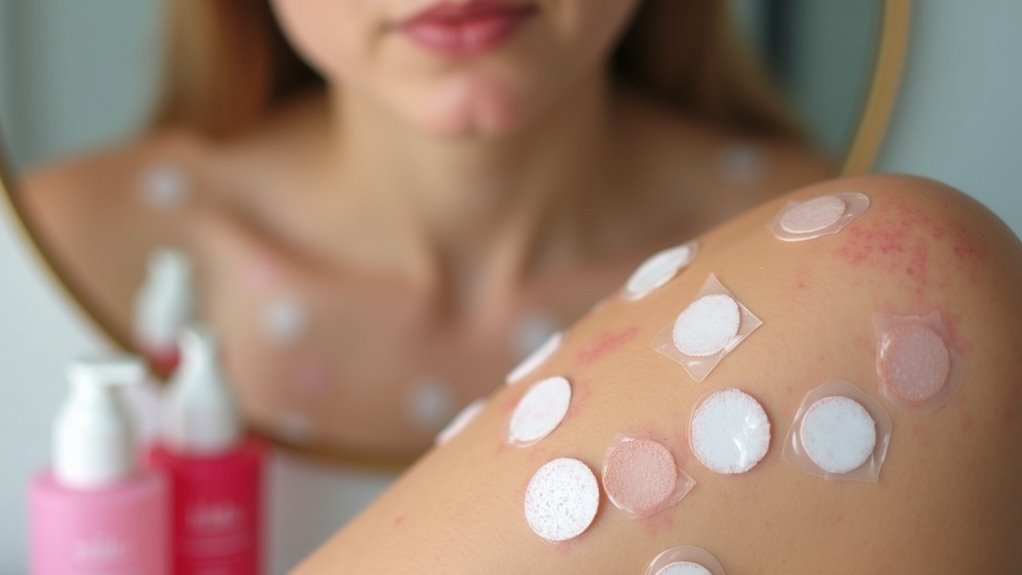
Using pimple patches can be an effective way to tackle breakouts, but many people make common mistakes that reduce their effectiveness.
To get the most out of your pimple patches, avoid these pitfalls:
- Applying on Non-Inflamed Pimples: Patches work best on visible, fluid-filled lesions like whiteheads, not on early-stage or non-inflamed spots.
- Skipping Cleansing: Always cleanse your face and hands thoroughly before you apply the patch to prevent introducing excess oil and bacteria to the area.
- Neglecting to Size Up: Choose the right size patch that fully covers the blemish. This maximizes absorption and treatment efficacy, making your skincare routine more effective.
Evaluating the Effectiveness of Pimple Patches
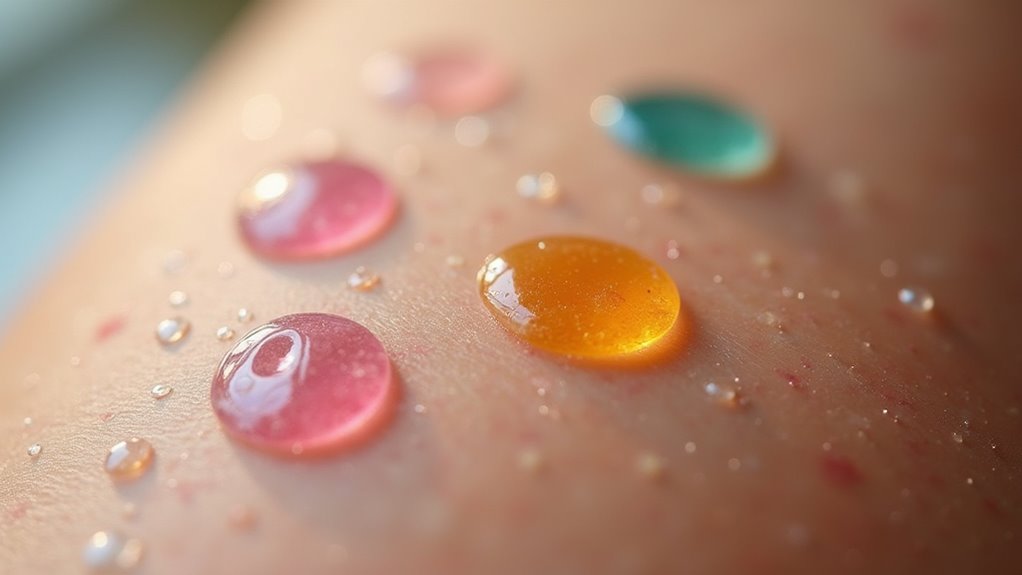
How effective are pimple patches in managing breakouts?
Pimple patches are particularly useful for treating individual, surface-level pimples, especially those that are inflamed and filled with pus. They use hydrocolloid gel technology to absorb excess fluid while creating a protective barrier, which can help reduce inflammation.
Pimple patches effectively treat inflamed, pus-filled pimples by using hydrocolloid gel to absorb fluid and reduce inflammation.
Studies show these patches outperform traditional bandages in controlling acne severity. However, it’s important to note that while pimple patches can expedite healing, they won’t prevent future breakouts or tackle underlying skin issues.
For best results, incorporate them into a consistent skincare routine rather than relying on them alone. Overall, pimple patches can be a valuable addition to your acne treatment arsenal when used correctly.
Suitable Skin Types for Pimple Patches
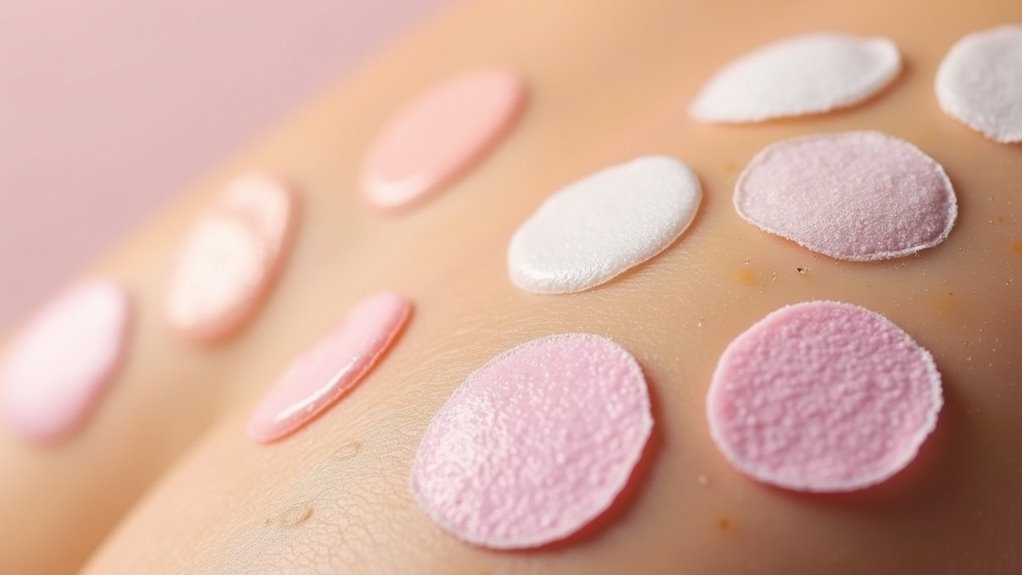
Pimple patches are a great option for everyone, no matter your skin type.
If you have sensitive skin, just keep an eye on the ingredients to avoid irritation.
For those prone to breakouts, these patches can be a game-changer, helping to tackle surface-level acne effectively.
All Skin Types Welcome
No matter your skin type, pimple patches offer a versatile solution for managing breakouts. They’re suitable for all skin types, including normal, oily, combination, and dry skin.
Here’s why they’re a great choice for everyone:
- Effective Acne Treatment: Pimple patches target surface-level acne, helping to reduce breakouts without harsh chemicals.
- Gentle on Sensitive Skin: Many patches contain soothing ingredients, making them ideal for those with sensitive skin.
- Prevent Irritation: They provide a calming alternative during flare-ups, minimizing the risk of irritation from harsher treatments.
With their ability to cater to various skin concerns, pimple patches can be a helpful addition to your acne-fighting arsenal, no matter your skin type.
Sensitive Skin Considerations
When it comes to sensitive skin, choosing the right products is essential for avoiding irritation and guaranteeing effective treatment. Pimple patches can be a great option, but you must check the ingredient lists to find gentle components. Hydrocolloid patches are particularly beneficial for sensitive skin, offering a soothing alternative to harsher acne treatments. They help minimize the urge to pick at blemishes, which can worsen irritation. If you’re considering AHA/BHA infused patches, make sure they’re not overly aggressive and apply them cautiously. Additionally, individuals with sensitive skin may want to consider using materials like Bioplast for their body jewelry to avoid irritation, as it is known for its flexibility and comfort.
| Skin Type | Suitable Products | Precautions |
|---|---|---|
| Sensitive Skin | Hydrocolloid Patches | Check ingredient lists |
| All Skin Types | Regular Pimple Patches | Guarantee no harsh ingredients |
| Cautious Users | AHA/BHA Infused Patches | Apply with care to avoid irritation |
Acne-Prone Skin Benefits
If you’re struggling with acne-prone skin, you’ll find that pimple patches offer numerous benefits tailored to your needs.
These acne patches are designed to help you manage surface-level breakouts effectively. Here are three key advantages:
- Absorb Excess Fluid: Pimple patches draw out excess moisture and pus, which can speed up healing.
- Reduce Inflammation: They help calm redness and swelling, making your skin look less irritated.
- Gentle for Sensitive Skin: Many patches contain soothing ingredients, minimizing the risk of irritation while providing relief.
Additionally, hydrocolloid technology is often used in these patches to promote healing by drawing out impurities.
While pimple patches are great for tackling surface-level breakouts, remember they mightn’t be as effective for deeper cystic acne.
Always consider them as a complement to your broader skincare regimen for best results.
Situations Where Pimple Patches Should Not Be Used

While pimple patches can be a handy tool for treating breakouts, there are specific situations where they shouldn’t be used.
First, avoid using pimple patches on cystic acne, as they won’t penetrate deep enough to provide relief. They also won’t work on closed lesions or blackheads, potentially causing irritation instead.
Avoid pimple patches for cystic acne, closed lesions, or blackheads, as they may irritate rather than help.
If you have early-stage pimples that haven’t formed a visible head, skip the patches; they’re most effective on surface-level pimples that are already inflamed.
Additionally, don’t apply patches to broken skin, irritated areas, or regions with active infections, as this can worsen your condition.
Alternatives to Pimple Patches for Acne Treatment
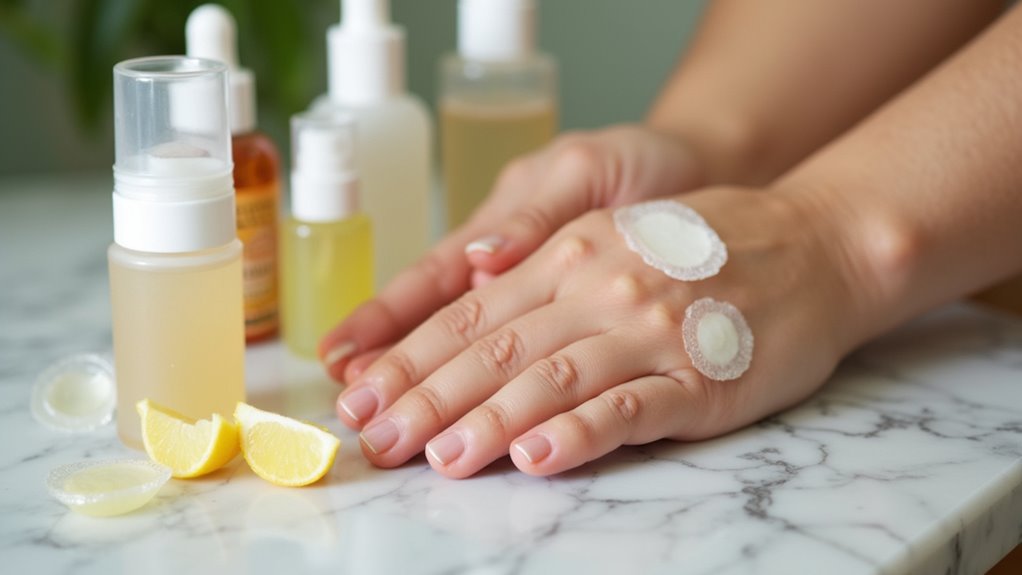
There are several effective alternatives to pimple patches for treating acne that can help you achieve clearer skin. Consider these options:
- Salicylic Acid: This powerful ingredient exfoliates and unclogs pores, preventing future breakouts, especially for surface-level acne.
- Benzoyl Peroxide: It targets acne-causing bacteria and reduces inflammation, making it great for various types of acne.
- Retinoids: These topical treatments promote skin cell turnover, helping to prevent clogged pores and treat existing lesions.
Additionally, clay masks can absorb excess oil and impurities, offering a detoxifying effect.
For severe cases, don’t hesitate to consult a dermatologist for professional treatments like chemical peels or laser therapy.
These alternatives can be effective, enhancing your skincare routine.
Final Thoughts on the Role of Pimple Patches in Skincare

Although pimple patches can be a handy tool in your skincare arsenal, they should be seen as just one part of an extensive acne management strategy.
These acne patches excel at treating surface-level breakouts, absorbing excess fluid, and preventing bacteria spread. However, they don’t prevent future breakouts or tackle underlying skin issues.
Pimple patches effectively target surface-level breakouts and absorb fluid but do not prevent future blemishes or address underlying skin concerns.
The active ingredients, like hydrocolloid and AHA/BHA, work best on fresh, inflamed lesions but may not be effective for deeper cystic acne.
To maximize their benefits, follow proper application and removal guidelines to minimize skin irritation.
Ultimately, incorporate pimple patches into a broader skincare routine that addresses all aspects of acne to achieve the best results in your battle against blemishes. Additionally, understanding the common causes of acne can help you develop a more effective prevention strategy.
Frequently Asked Questions
Do Pimple Patches Work on Unpopped Pimples?
Yes, pimple patches can work on unpopped pimples, especially those infused with AHA/BHA.
They deliver active ingredients that help exfoliate and combat acne-causing bacteria. For best results, leave the patch on for at least 2 hours to reduce inflammation and speed up healing.
However, remember that they’re not a complete solution for your skincare routine and may not be effective on deeper cystic acne.
Do Pimple Patches Prevent Pimples From Forming?
Pimple patches don’t typically prevent pimples from forming. They’re mainly designed to treat existing blemishes rather than tackle the causes of acne.
While some patches contain ingredients that might reduce early breakout severity, they won’t stop new ones from showing up.
To effectively prevent future breakouts, you need a consistent skincare routine that includes acne-fighting products.
Are Pimple Patches Better Then Popping?
Imagine you’re dealing with a painful pimple. You’ve got two choices: pop it or use a pimple patch.
Popping can push bacteria deeper, leading to infection and scarring. In contrast, pimple patches draw out fluid, reduce inflammation, and protect your skin.
They not only speed up healing but also prevent you from picking at it. So, when it comes to treating breakouts, pimple patches are definitely the safer, smarter option for healthier skin.
Do Pimple Patches Get Rid of Underground Pimples?
Pimple patches can help with underground pimples, but their effectiveness depends on the pimple’s stage.
If it’s close to the surface, a patch might reduce inflammation and prevent you from picking at it.
However, for deeper cystic pimples, pimple patches may not do much. You might need other treatments or professional help for those.
Conclusion
In the garden of your skin, pimple patches serve as diligent gardeners, nurturing and protecting your blooms from the harsh elements. While they can’t prevent every storm, they stand ready to mend the tender buds before they burst. Just like a wise gardener knows when to let nature take its course, you’ll learn when to rely on these patches and when to seek other remedies. Embrace the balance, and watch your skin flourish in harmony.


